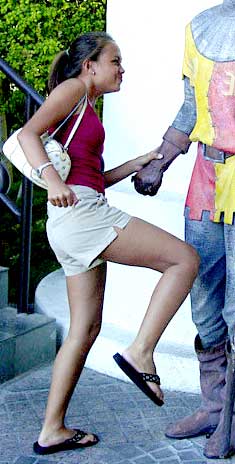thai kick
Think of this as “the other thai kick.” It’s a very practical technique, especially if you shorten the move by eliminating the “in between.”
Here’s what I am talking about …
The Thai Kicks That Most Know
Most people think of thai kicks as big sweeping motions that damage the leg. You imagine the thai boxer training by kicking against the trunk of a fairly narrow tree.
When the fighter kicks into his or her opponent’s leg, it kicks through the leg. Damaging … pain inducing. Owsie- kasowsie!
So, do you have that roundhouse, typical thai kick in mind?
That’s not the devastating kick that I am referring to. Here, keep reading …
Thai Kick Follow-Up Surprise
 The Thai Kick that I am referring to is really a follow-up move. I have seen it used by some of the better Thai Boxers.
The Thai Kick that I am referring to is really a follow-up move. I have seen it used by some of the better Thai Boxers.
Note: Although we are discussing it in the context of Thai Boxing, I learned the move while studying Filipino martial arts.
Imagine that you are close enough to your opponent to grapple him to the ground. You could have ahold of his head with both of your hands, and or maybe you are grabbing his arms.
You are definitely close enough for a knee strike. So, you kick with your knee to the groin.
Your enemy either blocks it with his forearm or fist, or he lifts his leg and turns a bit, to protect his groin.
The thai kick that I am referring to is your follow-up AFTER your knee shot gets foiled.
You immediately drop with your other knee right into (or onto) your opponent.
Remember, I mentioned earlier that there should be no pause or extra motion between the two kicks (strikes) with the knee. Bam-Bam!
Thai Kick Targets
So, after your initial leg lift to the groin gets checked, where should your secondary move go? What should you be aiming for?
My recommendation is that this second kick has a “drop” quality to it. Use gravity to plant your knee into AND onto your opponent’s thigh … or his calf … or into the cheek of his backside … or onto his ankle.
Really, whichever target is closest to your “second knee” is fine. Whatever you drop your full weight into should get damaged, right? (Careful during practice, please.)
Does the above make sense, or do I need (kneed 😉 to explain it in more detail?
Tags: follow-up moves, knee strikes, martial arts techniques, secondary kick, thai kick


